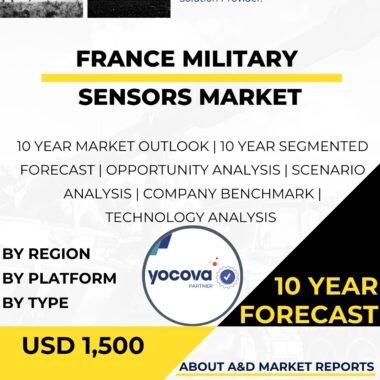Description
The South Korea military sensors market is a critical component of the country’s defense industry, providing advanced sensing technologies that enhance the capabilities and effectiveness of its armed forces. Military sensors are vital for collecting and processing data from various sources, enabling real-time situational awareness, target detection, and intelligence gathering. South Korea’s focus on indigenous development, strategic partnerships, and technological innovation has positioned it as a significant player in the global military sensors market.
Military sensors are instrumental in modern warfare, offering a diverse array of capabilities such as radar systems for air and missile defense, electro-optical sensors for surveillance and reconnaissance, acoustic sensors for underwater detection, and infrared sensors for target tracking. These sensors play a crucial role in supporting the military’s mission planning, decision-making, and threat response.
Indigenous development has been a cornerstone of South Korea’s defense strategy, and the military sensors market is no exception. The country’s defense industry, represented by companies such as Hanwha Systems and LIG Nex1, has made significant progress in developing advanced sensor technologies tailored to meet the specific requirements of the South Korean military.
In the aviation sector, South Korea has developed and deployed advanced radar systems for its fighter aircraft and air defense platforms. These radar systems provide long-range detection and tracking capabilities, enabling early warning against incoming threats and enhancing the situational awareness of fighter pilots.
In the naval domain, South Korea has invested in advanced maritime surveillance radars and sonar systems. These sensors allow naval vessels to detect and track surface ships, submarines, and other maritime threats, ensuring the safety and security of South Korea’s territorial waters and exclusive economic zones.
Moreover, South Korea has focused on developing electro-optical and infrared sensors for reconnaissance and surveillance applications. These sensors, mounted on UAVs, aircraft, and ground-based platforms, enable real-time intelligence gathering, target identification, and tracking, supporting various military operations and security missions.
Beyond domestic requirements, South Korea actively seeks strategic partnerships with international defense and technology companies to enhance its military sensor capabilities. Collaborations with global manufacturers enable technology transfer, joint research, and the integration of foreign systems into South Korea’s indigenous sensor platforms. These partnerships contribute to the continuous improvement of South Korea’s military sensor technology and reinforce its position in the global defense market.
Furthermore, South Korea’s commitment to innovation and research and development (R&D) has driven advancements in military sensor technology. The country invests in R&D programs to improve the performance, range, accuracy, and reliability of sensors. Technological improvements focus on enhancing data processing, reducing size and weight, and increasing the resilience of sensors to environmental and electromagnetic challenges.
As part of its broader defense industry, South Korea’s military sensors market extends beyond domestic needs. The country actively exports military sensors and related technologies to other nations, generating revenue and expanding its influence in the global defense market. Successful exports demonstrate the reliability and performance of South Korean-made sensor solutions, contributing to the growth of its defense industry.
To ensure optimal utilization and proficiency in operating military sensors, South Korea places significant emphasis on training and skill development for its military personnel. Training programs focus on familiarizing operators with the operation, maintenance, and effective utilization of sensors in various operational scenarios.
Moreover, cybersecurity is a critical consideration in the military sensors market, as sensors often incorporate digital components and may be vulnerable to cyber threats. South Korea invests in robust cybersecurity measures to safeguard its defense infrastructure and ensure the confidentiality and integrity of sensor data.
In conclusion, the South Korea military sensors market is a crucial aspect of the country’s defense capabilities. Indigenous development, strategic partnerships, and innovation have allowed South Korea to create advanced sensor technologies that meet the specific needs of its military. From radar and sonar systems for air and maritime defense to electro-optical and infrared sensors for reconnaissance and surveillance, these military sensors enhance the situational awareness and operational effectiveness of South Korea’s armed forces. As the defense industry continues to evolve, South Korea’s dedication to advancing its military sensor technology will remain essential in strengthening its national security and maintaining its position as a significant player in the global military sensors market.




